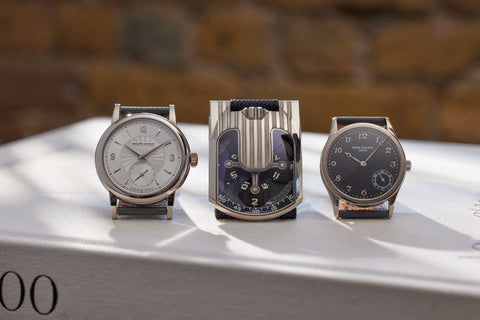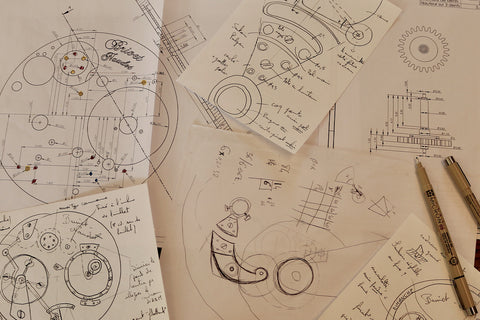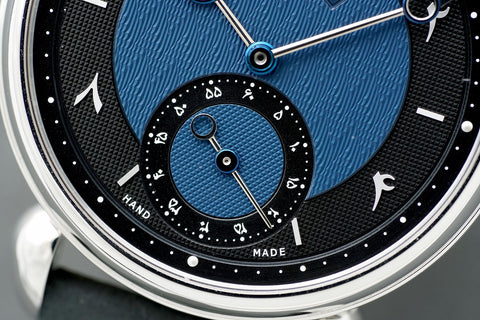A Pièce Unique from French watchmaker Florent Lecomte, this L-Pu02 is the first example from the workshop to feature a hand hammered dial. Originally Lecomte's personal watch and prototype, the watch was entirely refinished and adapted to be a unique piece for a client, with a new, semi-openworked dial and personal touches engraved on the movement. The history and transition that this watch has gone through make this an especially remarkable example.
Worth Reading
Florent Lecomte began his career as a teacher at the Lycee Edgar Faure in Morteau in 2006 – he had previously studied and taught industrial product design, and only discovered watchmaking after his transfer to the Morteau school. After two years of training, he specialised in teaching students about mechanical watches with complications. Some of Lecomte's pupils have included the likes of Remy Cools and Théo Auffret, all of whom have struck out on independent careers of their own. Lecomte's own independent career began in 2020, during lockdown. As of today, he has produced three different watch series in limited numbers, making this prototype-turned-unique-piece a rare chance to obtain an early and excellent example from a flourishing independent maker.
This L-Pu02 is the second unique piece to emerge from Lecomte's workshop. Originally a prototype, this was Lecomte's personal watch before he decided to refinish and adapt the parts to fulfil a client's request. The watch is cased in steel and at 42mm in diameter. An entirely new dial was created, marking the first time Lecomte attempted a hand-hammered dial. This took about 8 attempts to get the piece entirely to Lecomte's exacting standards, demonstrating great depth and texture across the dial's expanse.
Furthermore, the unique piece visually differs from the Series 1 by being part-openworked, giving more attention to the hand-hammering and a glimpse into the movement below. The main dial at 12 o'clock features a chapter ring to mark the minutes, with the wheels and gearing exposed near the centre, and a second screwed on bridge seen below. The hands are heat blued through a traditional "lampe à alcool" technique, where they are heated above a gas lamp or similar. Meanwhile, at 9 o'clock, we see that the sub-seconds act as a small porthole to the watch's inner workings. Components such as the chapter rings and wheels are brushed, while the bridges are black polished by hand, creating a distinctly smooth contrast against the busy dial texture.
On the movement side, Lecomte used a reworked ETA 6497 calibre. All visible engraving and finishing are done entirely by hand. A sandblasted texture is visible throughout, while all edges are sharply bevelled, and the wheels feature circular graining. Perlage can be seen on the baseplate, while each of the screws are black polished. The words "Piece unique - finitions main - Morteau" are engraved below the balance wheel, indicating that the watch was hand finished and created in Morteau. Additionally, a small engraving in Arabic can be seen to the left of the movement, a personalised touch from the client, which roughly translates to "treasure box". When applied to the watch, the intention was to suggest that "the watch is a piece of art, and the art is within it."
The watch comes with a detailed catalogue of photographs and videos that Lecomte took through the process of converting it from his personal watch to a pièce unique. This documentation, which will be shared with the new owner, shows processes such as the hand-hammering of the dial; heat-blueing of the hands; hand-engraving on various components; as well as the disassembly, assembly and testing carried out on the watch. The detail of these records presents a rare opportunity – one unavailable even to most who commission of pièce unique – to follow the workings of such an accomplished watchmaker.
Specifications
Closer look
| Brand: | Florent Lecomte |
| Model: | L-Pu02 Pièce Unique |
| Movement: | manual-winding |
| Functions: | hours, minutes, sub-seconds |
| Features: | hand hammered dial, lampe à alcool blued hands, semi-skeletonised dial |
| Case material: | stainless steel |
| Case diameter: | 42mm |
| Case thickness: |
13.5mm |
| Lug-to-lug: |
50mm |
| Crystal: | sapphire front & back |
| Strap: | saffiano strap from our own collection |
| Lug width: | 22 x 18mm |
| Year: | 2021 |
| Accompanying materials: | Outer wooden Lecomte box, warranty card (dated), Lecomte loupe. |
Condition
This Florent Lecomte Pièce Unique is in excellent overall condition. The case and lugs have been well preserved, with only light superficial marks consistent with minimal wear over time. The hand-hammered dial, lampe à alcool blued hands, and movement are free from any signs of imperfections.
The watch comes with a detailed catalogue of photographs and videos that Lecomte took through the process of converting it from his personal watch to a pièce unique. This documentation, which will be shared with the new owner, shows processes such as the hand-hammering of the dial; heat-blueing of the hands; hand-engraving on various components; as well as the disassembly, assembly and testing carried out on the watch. The detail of these records presents a rare opportunity – one unavailable even to most who commission of pièce unique – to follow the workings of such an accomplished watchmaker.
Warranty
The watch comes with a two-year warranty from A Collected Man, alongside a lifetime guarantee of authenticity.
We stand by the quality of all of our pre-owned watches and mechanical objects. If something goes wrong, we’ll always strive to remedy the situation in a timely manner and to the best of our ability. The satisfaction and trust of our clients is of the highest importance, to everyone at A Collected Man.
All of our pre-owned watches have undergone thorough, non-invasive mechanical inspections and have been serviced, if appropriate, to ensure that they meet our highest standards of timekeeping and functionality.
Our pre-owned watches, unless stated otherwise, are covered by either a full or a limited twenty-four month warranty. This excludes any damage sustained due to improper use or accident. Due to their age, some pre-owned watches should not be subjected to the same conditions as when new.
Any of our pre-owned watches which have been serviced by their respective manufacturer, will carry the manufacturer’s servicing guarantee. This is separate and supersedes, the standard warranty offered by A Collected Man. Please see our Terms & Conditions for further information. You can write to us directly at enquiries@acollectedman.com, for further clarification.
A Collected Man is also an authorised retailer for a number of watchmaking brands. These watches are covered by the warranty from the original manufacturer.
*Holiday Shipping Dates*
The last day of shipping will officially be Wednesday, 17th December (we may accommodate other requests, on a discretionary basis). The last guaranteed international shipping date shall be Friday, 12th December.
We offer complimentary worldwide delivery on our watches. If ordering from overseas, delivery will depend on the value of the timepiece and the destination. All import taxes, duties and tariffs are the responsibility of the buyer.
If ordering from the UK before 1 PM, your watch will be sent the same working day. The courier will depend on the value of the watch, with all watches delivered the next working day.
Please note that pre-owned goods (in the United Kingdom) are subject to a marginal rate of VAT, which can not be reclaimed. For further information, please see here.
Enquire
Please fill out the details below and we'll be back in touch shortly. Thank you.
Join the List
Get notified as soon as new pieces from this brand are added to our collection.
What is independent watchmaking?
Giving a straightforward definition of independent watchmaking is a near impossible task. In recent years, the question has become even harder to answer – ask any collector what they would define as “independent” and you’ll almost certainly get a wide range of answers, each drawing different parameters for the category, or defining it by completely different rules.




Notably, a condition for becoming a member of the Académie Horlogère des Créateurs Indépendants (AHCI) is that the watchmaker should “independently develop and produce their creations” but, once again, leaves the word “independent” up for debate. In the context of the AHCI’s creation, we can perhaps comfortably assume that they mean watchmakers who are independent of big brands or larger conglomerates. But since then, the world of independents has only grown and, with it, the many different interpretations of watchmaking that each artisan brings to the table.
At its very core, the term “independent” is defined as “not [being] influenced or controlled in any way by other people, events, or things”. Within watchmaking, this does not only have financial implications, but can also have creative, technological, or literal ones, especially regarding the watchmakers themselves.




















































































































































































































































































































